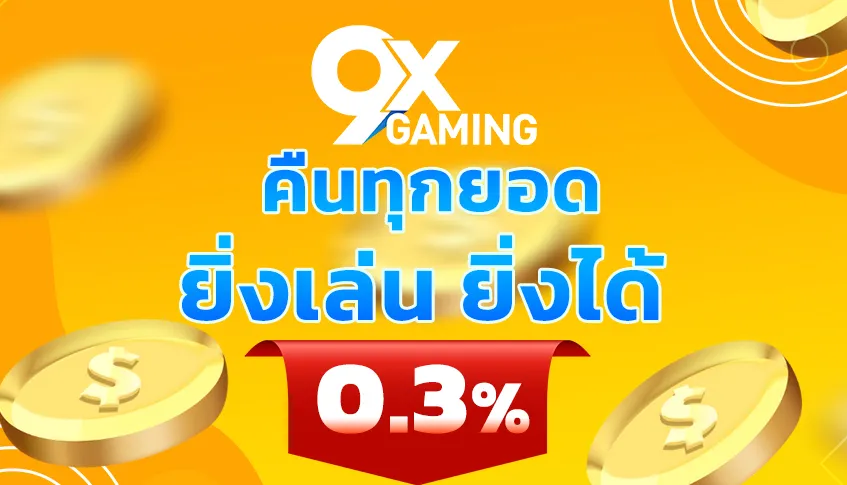
เว็บตรง สล็อต 9xsport สล็อต
9xsport สล็อต เป็นเว็บไซต์การพนันออนไลน์ ที่มีเกมให้บริการทุกรูปแบบ พร้อมระบบบริการสมบูรณ์ เพื่อความสนุกและความพึงพอใจ ของผู้เล่นทุกคน เมื่อเลือกที่นี่เล่นเกมและเดิมพันออนไลน์ คุณจะได้สัมผัสประสบการณ์ ที่ไม่เหมือนใคร และให้คุณค่าในการลงทุนที่แท้จริง
จึงทำให้ เมื่อคุณมาสนุก กับการพนันออนไลน์กับเรา คุณจะได้รับเพียงแต่ประสบการณ์ที่ดีที่สุดที่ไม่เคยมีมาก่อน เว็บไซต์การพนันออนไลน์ ที่มอบความสนุก และประสบการณ์การเดิมพัน ที่เป็นเอกลักษณ์แก่ผู้เล่นทุกคน จึง เล่นสล็อตออนไลน์เพื่อเพิ่มโอกาสในการชนะรางวัลใหญ่ สล็อต เว็บตรง การเล่นพนันออนไลน์ช่วย เพิ่มโอกาสชนะรางวัลเงินสดใหญ่ และเพิ่มโอกาสชนะรางวัลเงินสดใหญ่อย่างมาก
9x sport สล็อต ประสบการณ์การเล่นการพนันที่ดีที่สุด
tombuechner.com จึง 9xsport สล็อต เรามุ่งมั่นที่จะให้ประสบการณ์ การเล่นการพนันที่ดีที่สุด แก่ผู้เล่นทุกคนที่เข้ามาใช้บริการ ทำให้การเล่นพนันออนไลน์เป็นประสบการณ์ที่น่าตื่นเต้น เชื่อมโยงกับคาสิโนแบบเสมจริง ด้วยเกมส์ที่ไม่เหมือนใคร และไม่มีการจำกัด ผู้เล่นสามารถเพลิดเพลิน กับประสบการณ์ การเล่นเกมพนันออนไลน์ที่มีความท้าทาย และน่าดึงดูด เหมือนการเล่นในคาสิโนจริง โดยที่ไม่ต้องเสียเวลา ในการเดินทางไปที่สถานที่ การพนันในคาสิโนจริง 24/7 ที่ ไม่มีขั้นต่ำ Pigusso slot
เว็บไซต์ที่ทันสมัย และเปลี่ยนแปลงอยู่เสมอ ซึ่งทำให้เราเป็นแหล่งสร้างรายได้ จากการพนันออนไลน์ ผู้เล่นมีความรู้สึกว่าได้เว็บไซต์ เล่นเกมสล็อตที่ให้บริการดีเยี่ยม และสามารถเล่นได้ทันที ด้วยการเดิมพันขั้นต่ำเพียง 1 บาทที่ดีที่สุดในปัจจุบันล่าสุด และ sunstarสล็อต ท่านที่เข้ามาสมัคร คาสิโนออนไลน์ไม่มาก วันนี้คุณพร้อมที่จะเริ่มหรือยัง?
9x sport สล็อต โบนัสใหม่ สนุกทันสมัย
tombuechner.com การเดิมพันออนไลน์ที่ไทย กำลังได้รับความนิยม เนื่องจากความสนุกสนาน ที่ไม่มีที่สิ้นสุดในปัจจุบัน. เนื่องจาก 9xsport สล็อต สมัครสมาชิก และใช้บัญชีเดียวสำหรับ การเดิมพันออนไลน์ทุกประเภท เปลี่ยนเกมการพนันออนไลน์ ให้ได้มากที่สุด เพื่อความสนุกสนานทุกช่วงเวลา
เล่นพนันออนไลน์รวดเร็ว และได้รับโบนัสมากมาย ที่ สล็อตแมชชีน ไม่มีขั้นต่ำ 9sport สล็อต เพลิดเพลินกับความสนุกสุดพิเศษ จากการเล่นพนันออนไลน์ ที่ได้รับความนิยมอันดับ 1 ที่ทุกคนต่างชื่นชอบโดยการใช้บัญชีและทะเบียนเดียวกัน การเดิมพันออนไลน์เสี่ยงทาย แต่สามารถทำให้คุณได้รับรางวัล
และชนะได้อย่างรวดเร็วจากทุกที่ทุกเวลา คุณควรพิจารณา และเลือกเกมพนันออนไลน์ที่ดีที่สุดก่อนที่คุณจะลงทุนเดิมพันออนไลน์ว่าจะเริ่มอย่างไรแม้คุณ อาจสับสนในการเลือก เกมพนันออนไลน์ที่ดีที่สุด แต่หากผู้เล่นใหม่ยังไม่รู้ว่า จะเริ่มเดิมพันจากตรงไหน
9xsport สล็อต ไม่มีขั้นต่ำ
เว็บพนันออนไลน์ ที่สามารถถอนเงิน ได้อย่างสะดวก 24 ชั่วโมงทุกวัน โดยไม่ต้องผ่านตัวแทน และใช้ระบบอัตโนมัติในการเติมถอนเงิน 9xsport สล็อต ทายผลกีฬาและลอตเตอรี่ออนไลน์ ทุกจังหวัดทั่วประเทศ ฝาก-ถอนรวดเร็ว 24 ชั่วโมง บริการตลอด 24 ชั่วโมง ฟรี ทุกสถานที่ ไม่มีข้อ จำกัด ยินดีต้อนรับสู่โลกของ การพนันออนไลน์ที่ทันสมัยและมั่นคงที่สุด
ที่คุณสามารถเพลิดเพลิน กับการเดิมพันออนไลน์ ได้อย่างสนุกสุด โดยที่ไม่ต้องกังวล เรื่องการถอนเงิน เพราะเรามีความมั่นใจ ว่าคุณจะได้รับเงินได้ 100% โดยไม่ต้องผ่านตัวแทน เว็บไซต์พนันออนไลน์ ที่ใช้ง่ายและรองรับ ทุกสไตล์ผู้ใช้งานตลอด 24 ชั่วโมงทุกวัน ที่ ไม่มีขั้นต่ำ
9xsport Gaming การเข้าร่วมการพนันออนไลน์ สะดวกและรวดเร็ว แต่อาจเสี่ยงต่อความสูญเสีย ทางการเงินและเวลาได้อย่างมาก ทำให้คุณเสี่ยงต่อการเสี่ยงใหญ่ และทำให้คุณสูญเสียเงิน และเวลาอย่างมาก 24 ชั่วโมงทุกวัน. ระบบการันตีการจ่ายเงินรางวัล แก่ผู้เล่นออนไลน์ที่ใช้บริการจริง ในระบบเกมของเราเป็นเว็บพนันที่ทำให้ผู้เล่นถอนเงินได้ 100% โดยไม่ต้องผ่านตัวแทนที่รับประกัน และ เว็บไซต์เล่นพนันออนไลน์ ปลอดภัย รวดเร็ว ด้วยระบบอัตโนมัติทันที ตอบสนองทุกสไตล์ผู้ใช้งาน.

9xsport สล็อต เว็บไซต์การพนันออนไลน์ที่ดี
9xsport สล็อต เว็บพนันที่เป็นที่นิยมสูงสุดในประเทศไทย ด้วยคุณภาพที่ยอดเยี่ยม และการบริการที่ดีเยี่ยมที่สุด ทางเราใส่ใจในความปลอดภัยและความรวดเร็วเพื่อความมั่นใจ ของผู้เล่นทุกท่านในการเล่นพนันออนไลน์กับเรา. เล่นคาสิโนออนไลน์ ด้วยเกมสล็อตระดับโลกที่ทันสมัย และน่าสนใจที่สุดในโลก เพลิดเพลินและรวยร่ำรวย
เพื่อให้ N9ne bet slot พร้อมมอบประสบการณ์ การเล่นพนันที่สุดคลาสสิคตลอด 24 ชั่วโมงแบบไม่มีขีดจำกัดทุกราคา ทุกรูปแบบ ทุกระดับอายุ และทุกความต้องการ พร้อมสร้างประสบการณ์ การพนันที่สุดคลาสสิคตลอด 24 ชั่วโมง เล่นสนุกถูกใจทั้งวัยรุ่นและคนทำงาน
คุณสามารถเดิมพัน ออนไลน์ได้อย่างมั่นใจ เพราะระบบเกมจะทำงานอย่างมีประสิทธิภาพ และคุณจะได้รับเงินรางวัลทุกครั้งที่ชนะเลิศ โดยไม่ต้องกังวลเรื่องการจ่ายเงิน
การพนันออนไลน์ที่เพิ่มขึ้นทั่วประเทศไทยเป็นเรื่องที่มีความสะดวกสบายและไว้วางใจจากลูกค้ามากขึ้น นากาเวย์เว็บไซต์การพนัน ที่คุณต้องเลือกถ้าคุณต้องการชนะรางวัลใหญ่ ในการเล่นเกมออนไลน์! อีกทั้งยัง Pigusso slot
9 x sport สล็อต เว็บสล็อตออนไลน์ชั้นนำ
9xsport Gaming เว็บไซต์การพนันสล็อตออนไลน์ ที่ให้บริการบนมือถือ อย่างสะดวกสบาย และง่ายต่อการใช้งานที่สุด เว็บไซต์ใหม่ปี 2024 เปิดตัวเกมสล็อตใหม่มาแรง! สมัครเล่นวันนี้รับโบนัสต้อนรับ 100% ทันทีล่าสุด! สมัครสมาชิกและรับโบนัสทันที โดยไม่ต้องคืน ไม่มีเงื่อนไข ไม่ต้องรอช้า
โดยที่ 9sport สล็อต เป็นเว็บพนันที่ให้บริการครบวงจร และเป็นที่ที่สะดวกสบายที่สุด ในการเดิมพันของท่านทุกคน เว็บใหม่ คุณสามารถทำให้ชีวิตของคุณ เปลี่ยนไปเป็นใหม่พร้อมเป็นเศรษฐี และรวยได้ในการเข้าเล่น พนันออนไลน์ครั้งแรก ที่เว็บไซต์เดียวหลายรอบ ความปลอดภัยและคุณภาพเยี่ยม ในการเดิมพันออนไลน์ ที่ไม่มีที่ไหนที่ดีเท่านี้ เว็บพนันที่มั่นคง ปลอดภัย และมีบริการคุณภาพเยี่ยม N9ne bet slot
บทความเพิ่มเติม

mRNA
วัคซีนโควิด mRNA ช่วยชีวิตคน หรือเพิ่มความเสี่ยงให้ตาย-พิการ mRNA ตกลงวัคซีนโควิด ช่วยชีวิตคนตามหลักทางการแพทย์ หรือเพิ่มความเสี่ยงให้คนเสียชีวิตและเจ็บป่วยมากขึ้นจริงหรือ? จากข้อถกเถียงที่เกิดขึ้นในขณะนี้ หลังโควิดระบาดเข้าสู่ปีที่ 5 กลายเป็นคำถามของผู้คนจำนวนหนึ่งในสังคม เพราะเริ่มเกิดความตื่นตระหนกวิตกกังวล และอาจกลัววัคซีนโควิด เกรงว่าจะเกิดผลกระทบต่อร่างกาย

แมนซิตี พบ เบรนท์ฟอร์ด
แมนซิตี พบ เบรนท์ฟอร์ด ยิง1-0 ไล่จี้หงส์ลุ้นจ่าฝูง แมนซิตี พบ เบรนท์ฟอร์ด เกมฟุตบอลพรีเมียร์ลีก อังกฤษ 2023-2024 นัดตกค้างประจำคืนวันอังคารที่ 20 กุมภาพันธ์ เป็นการพบกันระหว่าง

มอสจักรพันธ์
มอสจักรพันธ์ นักแสดงละครคุณธรรม ถูกจับคดีถ่ายคลิปลับแบล็กเมล์รีดเงิน มอสจักรพันธ์ เปิดภาพนักแสดงละครคุณธรรม “มอส ดอยแม่สลอง” ผู้ต้องหาคดีรีดทรัพย์และข่มขืนใจผู้อื่น หลังตำรวจสืบนครบาลจับกุมกรณีส่งคลิปแอบถ่ายมีเซ็กซ์กับผู้เสียหายเพื่อบีบให้โอนเงิน หลังที่ผ่านมาตีสนิทแล้วหลอกยืมเงินหลายครั้ง ขณะที่ฝ่ายชายยอมรับ ชอบวันไนต์สแตนด์แล้วแอบถ่ายคลิป อ้างเก็บไว้ดูเอง ผ่านศึกบนเตียงมาแล้วนับร้อยราย วันนี้







